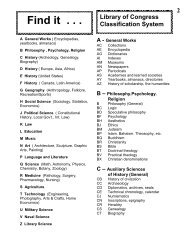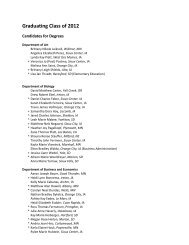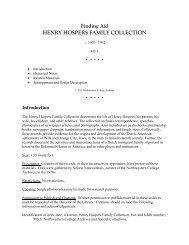Summer 2010 - Northwestern College
Summer 2010 - Northwestern College
Summer 2010 - Northwestern College
- No tags were found...
Create successful ePaper yourself
Turn your PDF publications into a flip-book with our unique Google optimized e-Paper software.
COVER STORYCOVER STORYHundreds of Haitian earthquake victims received medicaltreatment aboard the Comfort, a U.S. Navy hospital ship thatspent two months anchored in the bay outside Port-au-Prince.Den Hartog and his colleagues were evacuated from Haiti on anAir Force transport plane three days after the earthquake hit.Just 14 hours prior to the team’s departure, the first Americantroops landed in the country to provide humanitarian support, disasterrelief, and security.“It’s hard for people to understand just how disabled Port-au-Princewas the first few days,” Den Hartog says. “The United States military isprobably the best kind of an organization to handle these kinds of majorcatastrophes.”Robin (Van Oosterhout ’92) Lewis, a Public Health Servicepsychologist, agrees. She spent six weeks on the Comfort, a U.S. Navyhospital ship that arrived in Haiti the week after the quake and wasanchored in the bay outside Port-au-Prince for two months. A convertedoil tanker, the Comfort has 12 operating rooms, a medical staff of 550,and a 1,000-bed capacity.“The injuries were just incredible,” Lewis says. “There were a lot ofcrush injuries beyond repair, and because it had been a week since theearthquake by the time the Comfort arrived, severe infections had set in.”The ship’s surgeons performed more than 850 operations duringthe Comfort’s time in Haiti, and while numerous amputations werenecessary, physicians were also able to save many injured limbs. Lewis,who was known as “Dr. Ma’am” by the Haitian children on board,provided assessment and counseling for the patients who had beentraumatized by the disaster.The 18-hour workdays were exhausting, but the work, meaningful.Lewis found herself doing whatever was necessary: emptying bed pans,changing IV bags, feeding adults, cleaning blood off the floor. In ane-mail to family and friends, she wrote: “I never thought I would practicedeep breathing/relaxation with a patient while he was having his rawstump cleaned. I never thought I would be exploring occupations witha woman with no arms. I never thought I would be holding children atnight as they cry themselves to sleep longing for their mommies.”Lewis also provided support to the staff—some of whom, thoughseasoned combat veterans, were brought to tears by the suffering theysaw. Also difficult was the prospect of sending patients back home, wherecontinued treatment and therapy would be inadequate for their needs.On many occasions Lewis ended up escorting children to orphanages,which gave her a close-up view of Haiti. “It was the worst poverty I’veever seen in my life,” she recalls. “I’d seen Third World poverty before.I’ve just never seen it to the extent that was Haiti.”Faced with such acute poverty, people search for answers—anexplanation for Haiti’s problems. Dr. Paul Farmer is a physicianand professor at Harvard Medical School who has worked inHaiti for more than 25 years as the founder of Partners in Health.According to Farmer, it’s convenient to attribute the country’s ills tocauses native to Haiti.“Among the most popular explanatory models are those invoking‘cultural’ factors,” he writes in his book The Uses of Haiti. “Voodoo, inparticular, is often evoked to ‘explain’ Haiti.”While Roman Catholicism is the official religion of Haiti, Voodoomay be considered the country’s national religion. Haitian VoodooROBIN LEWISblends many of its rituals and beliefs—brought by slaves from Africa—with Catholicism. Central to Voodoo is the practice of serving andcommunicating with spirits.“There’s a joke rooted in fact that says Haiti is 80 percent Catholic,20 percent Protestant, and 100 percent Voodoo,” says JeanJeanMompremier. “That’s because everyone, Christians and non-Christians,has to deal with Voodoo all the time.”Televangelist Pat Robertson made headlines when he said Haiti’searthquake happened because the country is cursed for making “apact with the devil.” His comments referred to accounts, passed downthrough the years, of a Voodoo ceremony that served as a catalyst for theslave uprising that started the Haitian Revolution.The reasons for Haiti’s misery, however, are much more complex.As Farmer writes, “Haitians found themselves in a world entirelyhostile to the idea of self-governing blacks. [Anthropologist] SidneyMintz puts it neatly when he suggests that the birth of Haiti was a‘nightmare’ for every country in which slavery endured.”In a concerted effort, the UnitedStates and Western Europe tooksteps to cripple the new nationpolitically and economically. TheU.S. refused to grant diplomaticrecognition to Haiti for nearly 60years and pressured other countriesto do the same.In 1825, faced with a globaleconomic embargo imposed bythe United States and Europe,Haiti was forced to accept France’sdemands for compensation of 150million francs for the losses of theplantation owners. Payments onloans to cover the debt—equalto half a billion U.S. dollarstoday—had a catastrophic impacton Haiti’s economy.Similar injustices permeateHaiti’s history. Divided by raceand class, the country—95 percentblack and 5 percent mulattoand white—is controlled by a few elite families that stepped into thepositions of the former colonial plantation owners. Just 1 percent ofHaiti’s people own 50 percent of the country’s wealth.The poor in Haiti are used as a source of cheap labor. In 1925 anAmerican financial newspaper lauded the fact that the average Haitian“gives a hard day’s labor for 20 cents, while in Panama the same day’swork cost $3.” Fifty years later, U.S. manufacturers were taking advantageof a 70 percent unemployment rate and wages of 14 cents per hour toJOE RAEDLE/Getty ImagesAlthough it has been months since the earthquake devastatedPort-au-Prince and the surrounding area, hundreds of thousands ofpeople are still living in tents in makeshift camps.establish assembly plants in Haiti.By tradition, those who rule Haiti view the country as their privateproperty and its treasury as their bank account, says journalist and authorAmy Wilentz. Perhaps that’s why, over the course of nearly 200 years,Haiti has experienced more than 30 coups and suffered under a seriesof dictators backed by a repressive military, Haiti’s elite and foreigninterests.As much as 40 percent of Haiti’s more than $1 billion debt today isdue to loans made to the brutal dictators François “Papa Doc” Duvalierand his son, Jean-Claude. During their reign, writes Farmer, the U.S.Department of Commerce produced figures to show that “no less than63 percent of all recorded government revenue in Haiti was being‘misappropriated’ each year.” At one point, Haiti’s finance ministerrevealed that “a monthly average of $15 million was being diverted frompublic funds to meet ‘extra-budgetary expenses’ that included regulardeposits into [Duvalier’s] private Swiss bank account.”With such a history of oppression and corruption, it’s little wonderHaiti lacked the construction standards, infrastructure, health care andplanning to help it cope with a killer earthquake.In the weeks following the disaster, the eyes of the world werefocused on Haiti, and donations for relief efforts topped $305million.Sarah Earleywine, a <strong>2010</strong> <strong>Northwestern</strong> graduate from Brodhead,Wis., participated in six different mission trips to Haiti during high26 SUMMER <strong>2010</strong><strong>Northwestern</strong> Classic 27
















